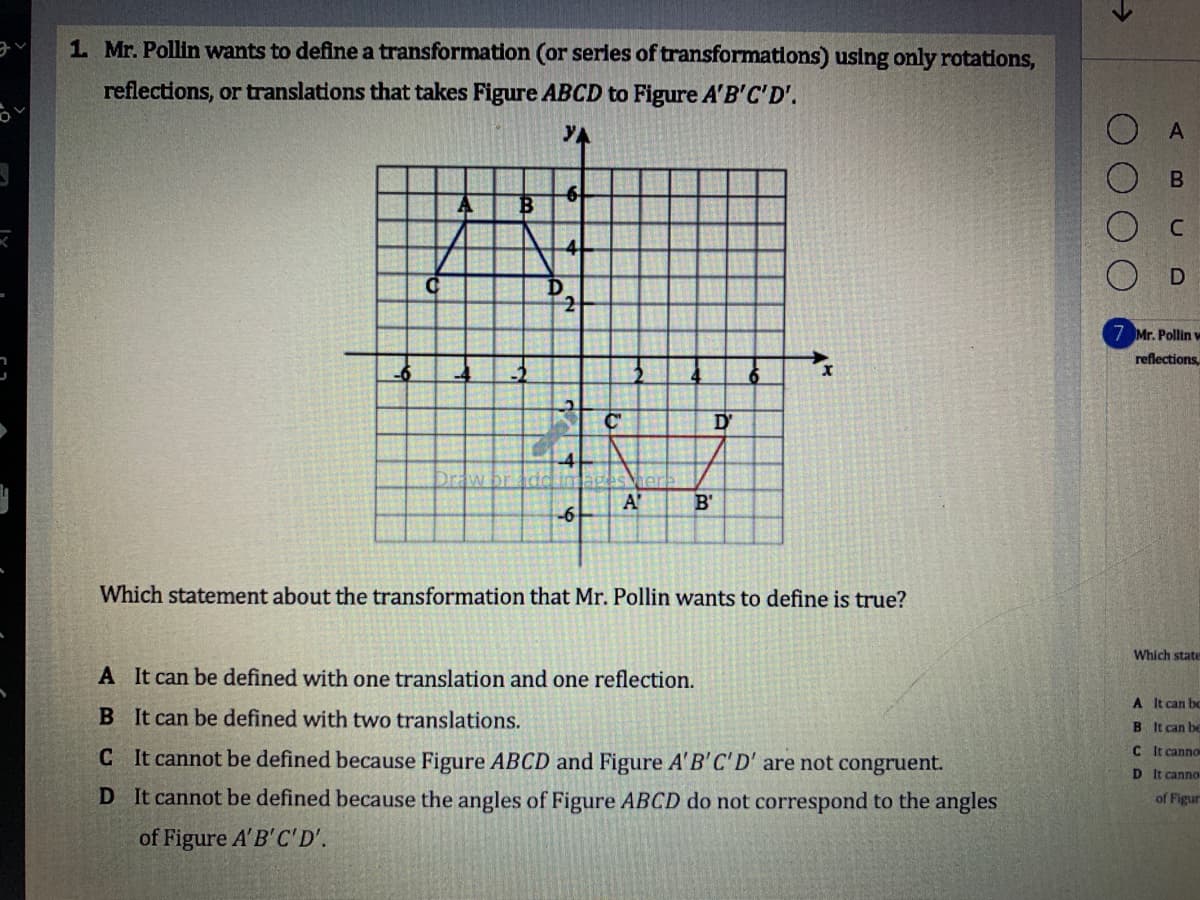1. Mr. Pollin wants to define a transformation (or series of transformations) using only rotations, reflections, or translations that takes Figure ABCD to Figure A'B'C'D'. YA -6 -4 2 D' A' B' -6- Which statement about the transformation that Mr. Pollin wants to define is true? A It can be defined with one translation and one reflection. B It can be defined with two translations. C It cannot be defined because Figure ABCD and Figure A'B'C'D' are not congruent. D It cannot be defined because the angles of Figure ABCD do not correspond to the angles of Figure A'B'C'D'.
1. Mr. Pollin wants to define a transformation (or series of transformations) using only rotations, reflections, or translations that takes Figure ABCD to Figure A'B'C'D'. YA -6 -4 2 D' A' B' -6- Which statement about the transformation that Mr. Pollin wants to define is true? A It can be defined with one translation and one reflection. B It can be defined with two translations. C It cannot be defined because Figure ABCD and Figure A'B'C'D' are not congruent. D It cannot be defined because the angles of Figure ABCD do not correspond to the angles of Figure A'B'C'D'.
Linear Algebra: A Modern Introduction
4th Edition
ISBN:9781285463247
Author:David Poole
Publisher:David Poole
Chapter6: Vector Spaces
Section6.4: Linear Transformations
Problem 15EQ
Related questions
Question
100%

Transcribed Image Text:1. Mr. Pollin wants to define a transformation (or serles of transformations) using only rotations,
reflections, or translations that takes Figure ABCD to Figure A'B'C'D'.
YA
-6
B
4.
7 Mr. Pollin w
reflections
D'
Draw bradd im
rer
A'
B'
-6
Which statement about the transformation that Mr. Pollin wants to define is true?
Which state
A It can be defined with one translation and one reflection.
A It can be
B It can be defined with two translations.
B It can be
C It canno
C It cannot be defined because Figure ABCD and Figure A'B'C'D' are not congruent.
D It canno
D It cannot be defined because the angles of Figure ABCD do not correspond to the angles
of Figur
of Figure A'B'C'D'.
->
OOOO
Expert Solution
This question has been solved!
Explore an expertly crafted, step-by-step solution for a thorough understanding of key concepts.
This is a popular solution!
Trending now
This is a popular solution!
Step by step
Solved in 2 steps with 2 images

Knowledge Booster
Learn more about
Need a deep-dive on the concept behind this application? Look no further. Learn more about this topic, algebra and related others by exploring similar questions and additional content below.Recommended textbooks for you

Linear Algebra: A Modern Introduction
Algebra
ISBN:
9781285463247
Author:
David Poole
Publisher:
Cengage Learning

Linear Algebra: A Modern Introduction
Algebra
ISBN:
9781285463247
Author:
David Poole
Publisher:
Cengage Learning